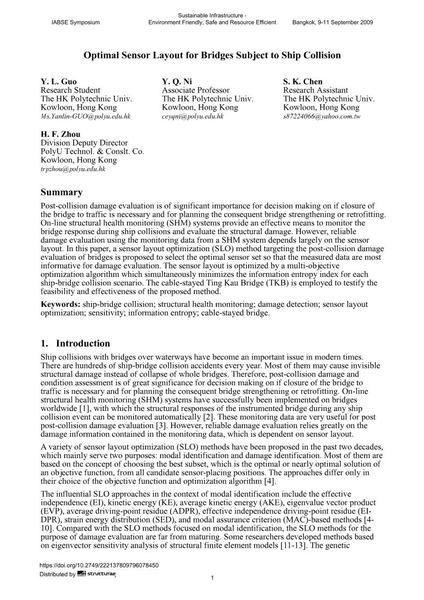Optimal Sensor Layout for Bridges Subject to Ship Collision

|
|
|||||||||||
Bibliographic Details
| Author(s): |
Y. L. Guo
Y. Q. Ni S. K. Chen H. F. Zhou |
||||
|---|---|---|---|---|---|
| Medium: | conference paper | ||||
| Language(s): | English | ||||
| Conference: | IABSE Symposium: Sustainable Infrastructure - Environment Friendly, Safe and Resource Efficient, Bangkok, Thailand, 9-11 September 2009 | ||||
| Published in: | IABSE Symposium Bangkok 2009 | ||||
|
|||||
| Page(s): | 71-80 | ||||
| Total no. of pages: | 8 | ||||
| Year: | 2009 | ||||
| DOI: | 10.2749/222137809796078450 | ||||
| Abstract: |
Post-collision damage evaluation is of significant importance for decision making on if closure of the bridge to traffic is necessary and for planning the consequent bridge strengthening or retrofitting. On-line structural health monitoring (SHM) systems provide an effective means to monitor the bridge response during ship collisions and evaluate the structural damage. However, reliable damage evaluation using the monitoring data from a SHM system depends largely on the sensor layout. In this paper, a sensor layout optimization (SLO) method targeting the post-collision damage evaluation of bridges is proposed to select the optimal sensor set so that the measured data are most informative for damage evaluation. The sensor layout is optimized by a multi-objective optimization algorithm which simultaneously minimizes the information entropy index for each ship-bridge collision scenario. The cable-stayed Ting Kau Bridge (TKB) is employed to testify the feasibility and effectiveness of the proposed method. |
||||
| Keywords: |
cable-stayed bridge structural health monitoring sensitivity damage detection Ship-bridge collision sensor layout optimization information entropy
|
||||
